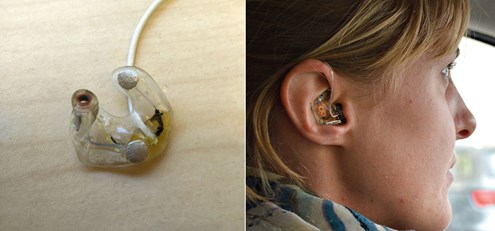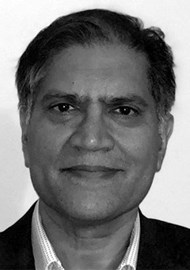Colver Ken Howe Ne, Jameel Muzaffar and Manohar Bance discuss the potential of hearable systems to monitor physiological signals (e.g. from brain or heart, blood pressure, body temperature) unobtrusively. Such adaptations require high-quality sensors and sophisticated de-noising signal processing on a low-power system to effectively remove artefact whilst not draining battery life.
Hearables are wearable electronic devices placed in, or around, the ear which modify/enhance listening experiences. They come in numerous forms, including headphones, earbuds, earlobe clips and other custom designs. Beyond audio recording, processing and playback, one useful application is that they can be used to record the wearer’s physiological signals over extended periods of time and in a variety of settings.
Examples include heart rate, body temperature, blood oxygenation (SpO2), blood pressure, electrocardiography (ECG) and electroencephalology (EEG). The concept of fitting multiple biosensors within a hearable to enable multimodality monitoring has become a topic of interest for the research and clinical communities. Hearables can be used for ambulatory health monitoring, sports medicine, sleep monitoring and several emerging interactive applications, through a brain-computer interface (BCI). BCIs aim to translate brain activity signals into digital commands for functions such as control of external devices and alternative forms of communication. In summary, hearables are appealing technologies which offer portable, unobtrusive and user-friendly monitoring - all key factors for enabling the operation of future mobile health systems.

Examples of in-ear EEG mounts. ©2016 Mikkelsen.kaare, CC BY-SA 4.0,
via Wikimedia Commons https://commons.wikimedia.org/wiki/File:Ear-EEG2.jpg
Sensing principles and potential applications
The ear is a favourable position for signal sensing due to its relatively fixed and stable location during daily activities compared to alternative locations such as the finger and arm. This is especially so for the ear canal. Other suitable locations include the conchae/cavum, earlobes or around the pinna. Another advantage is that the ear is a discreet and inconspicuous location to monitor signals, which imposes less restriction and is more comfortable for the wearer (in comparison to locations such as the chest or head). This makes the ear a potentially excellent candidate for wearable signal acquisition.
EEG
Conventional scalp-EEG measurements are the standard reference for clinical assessment as they offer better performance, such as a higher signal-to-noise ratio and more sampling space. However, such systems require attachment of multiple electrodes on the scalp and are movement intolerant. Moreover, they are cumbersome, precluding use for ongoing measurements. Hearables can potentially provide long-term EEG brain activity monitoring.
“While standard measurement methods and equipment are still preferred for clinical assessment, hearables offer a promising approach for ubiquitous monitoring in future mobile health applications”
Work in this area has been robust with numerous proposed functionalities. Ear-EEG has been shown to be effective in detecting both focal and generalised tonic-clonic seizures in hospital and laboratory settings [1]. Moreover, it has also shown to be effective at classifying sleep stages, distinguishing between wakefulness and sleep; and combined with electromyography for sleep detection [2].Ear-EEG has exciting applications in the field of BCIs.
Ear-EEG has shown potential in recording steady-state and evoked paradigms, including auditory steady-state potentials (ASSRs) and steady-state visual evoked responses (SSVEP). These signals can potentially be classified into commands to control external devices, which can benefit people with debilitating neurological conditions. Ear-EEG has also been shown to classify eye and facial gestures for applications like controlling a camera-mounted robot or a wheelchair [3]. This highlights the potential applications of ear-EEG in areas beyond ubiquitous health monitoring.
ECG
There is generally a good concordance between ear-ECG and reference measurements, with capability to detect some or all components of the ECG waveform. However, this is limited with a lower signal-to-noise ratio [4] and susceptibility to motion artefacts. Apart from their use in heart rate/blood pressure estimation, ECGs obtained from the ear have also been investigated for cardiac ambulatory and exercise monitoring. For example, this can involve integrating ballistocardiography (BCG), ECG and photoplethysmography (PPG) measures to estimate cardiac parameters like the heart rate, pre-ejection period, stroke volume, cardiac output and pulse transit time (PTT) [5]. This can potentially be used in arrhythmia detection and monitoring of congestive heart failure. This demonstrates the potential of integrating multiple sensors into a single device and employing algorithms to enable recording of detailed parameters simultaneously and ubiquitously from the ear.
Heart rate
There is a wealth of research and engineering studies that explore methods to record and estimate vital signals from the ear. Heart rate has been largely estimated using PPG, ECG waveform analysis and BCG methods. PPG involves optically estimating volumetric changes in ear blood vessels by measuring light absorption. Meanwhile, BCG involves the measurement of mechanical changes/forces as blood is pumped during systole.
“Ear-EEG has been shown to be effective in detecting both focal and generalised tonic-clonic seizures in hospital and laboratory settings”
The main advantage of heart rate measurements within the ear canal is its potential for reducing motion artefacts given the relatively fixed position of in-ear sensors compared to sensors placed peripherally (e.g. on the chest). Moreover, these sensors are less subject to the effects of centralisation, where blood perfusion to the periphery is reduced in critical conditions such as sepsis or hypothermia. These factors facilitate discreet, ubiquitous healthcare monitoring.
Body temperature
Body temperature measurements are conducted using thermopile sensors placed within the ear canal to measure the tympanic membrane temperature, which directly reflects the core temperature of blood. The key advantage is its non-invasive and unobtrusive nature compared to other forms of core temperature measurements such as rectal/oral measurements which are unsuitable for ubiquitous monitoring. Such devices can potentially be deployed in sports medicine and ambulatory monitoring.
Blood pressure
By measuring blood wave propagation time between two arterial sites on the body, also known as the PTT, an estimation of the blood pressure can be obtained. Current measurement techniques estimate PTT start and end time via ECG and PPG. The ECG heartbeat peak signals the PTT start time while the PPG measures volumetric changes as blood reaches the distal site, indicating PTT end time.
A key advantage of PTT estimation is that calculations are automated and measurement techniques are cuffless, thus enabling devices to be portable and less restrictive. PTT measurements, however, require two sensors for signal acquisition and their tolerance to motion artefacts is not well studied. This potential issue needs consideration for continuous monitoring applications within ambulatory settings.
SpO2
SpO2 is measured through photoplethysmography methods. Here, two wavelengths are presented simultaneously, and the ratio of absorbance enables an estimation of blood oxygen saturation. There are promising results demonstrating feasibility and convenience compared to standard measurement devices, although similar concerns regarding motion artefacts and recording extreme deviations from the norm need to be addressed before using them for continuous monitoring purposes within ambulatory settings.
Future work and improvements
Most published studies are preliminary and conducted within controlled laboratory conditions or within a hospital setting. The full impact of artefacts from daily activities like walking or interference from environmental noise has not been fully evaluated in many studies. More in-depth research is required on methods of de-noising such motion and environmental artefacts, which can impair signal quality. Furthermore, devices with wireless connectivity and appropriate battery life are essential for portability in everyday monitoring purposes. Hardware and physical limitations of multimodal devices should be considered, which may be physically larger and require greater computing power for signal integration and recording. Finally, comfort and wearability outcomes are equally important – this includes, among others, material choice for devices and the use of dry instead of wet electrodes. While standard measurement methods and equipment are still preferred for clinical assessment, hearables offer a promising approach for ubiquitous monitoring in future mobile health applications.
References
1. Gu Y, Cleeren E, Dan J, et al. Comparison between scalp EEG and behind-the-ear EEG for development of a wearable seizure detection system for patients with focal epilepsy. Sensors (Basel) 2017;18(1):29.
2. Nguyen A, Alqurashi R, Raghebi Z, et al. In-ear biosignal recording system: A wearable for automatic whole-night sleep staging. WearSys ‘16: Proceedings of the 2016 Workshop on Wearable Systems and Applications 2016;19-24.
3. Wang KJ, Zhang L, Luan B, et al. Brain-computer interface combining eye saccade two-electrode EEG signals and voice cues to improve the maneuverability of wheelchair. IEEE Int Conf Rehabil Robot 2017;1073-8.
4. Von Rosenberg W, Chanwimalueang T, Goverdovsky V, et al. Hearables: Feasibility of recording cardiac rhythms from head and in-ear locations. R Soc Open Sci 2017;4(11).
5. Da He D, Winokur ES, Sodini CG, et al. An Ear-Worn Vital Signs Monitor. IEEE Trans Biomed Eng. 2015;62(11):2547‑52.








